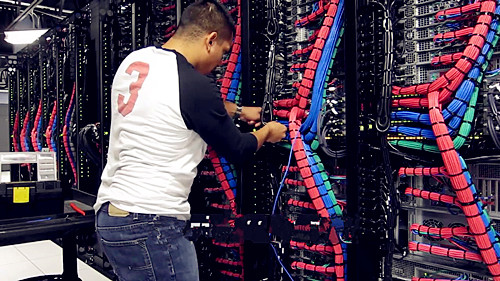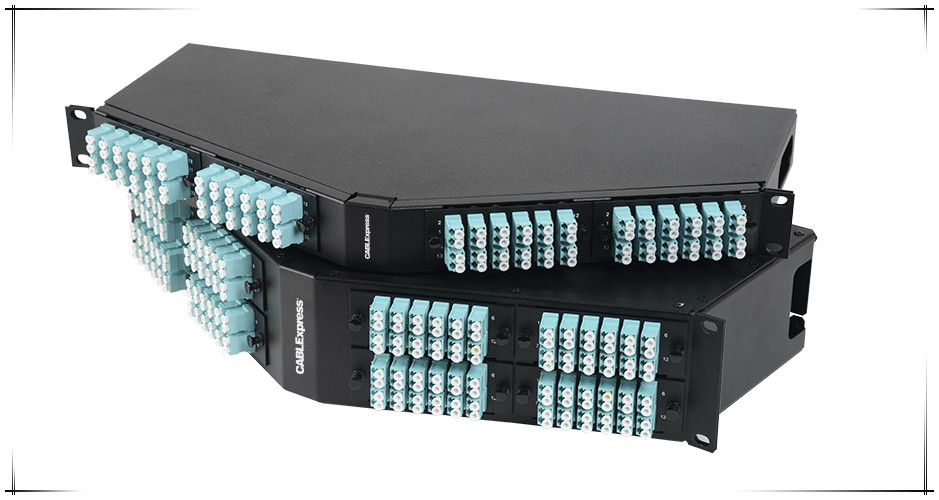As the growing demand for faster access to larger volumes of data, coupled with emerging high-speed network standards and rapidly advancing technology, fiber optic cables and cabling components have become a very popular element in data centers and high-speed networks. And when 10G fiber is the norm in most data centers today, the 40G fiber is also becoming commonplace. In this article, three effective solutions for 10G/40G connectivity will be introduced.
A breakout cable is a multi-strand cable which is divided into different specification cables. For example, a 40G breakout cable has four 10G duplex cables totaling eight strands, while a 100G breakout cable has 10 duplex cables and 20 strands.
To understand how breakout cabling solutions work, take integrating 10Gb servers into a 40G network for example. For each port on the switch, an MTP/MPO breakout cable which has an MPO/MTP connector on one end and four duplex LC connectors on the other end is needed. The MPO/MTP connector is plugged into the transceiver that connects with 40G switch and each duplex LC connector plugs into a 10G port on each server. If the switch has up to 32 40G ports, up to 128 10G devices can be connected to it using breakout cables.

This breakout cabling solution enables slower equipment to be connected to higher-speed equipment successfully, such as the 10G servers and 40G switch in our example. Up to 128 10G devices can be connected to a 32-port 40G switch.
MTP cassette provide secure transition between MTP and LC or SC discrete connectors. They are used to interconnect MTP backbones with LC or SC patching. Supporting various network cabling standards, the cassettes are easy to mix, match, add and replace as the connectivity needs grow or change.
Fiber cassettes are the key to modular systems. Available in multiple variations, the cassettes allow users to interconnect different fiber speeds simply by plugging standard LC cables into one side of the cassette and one or more standard MPO/MTP cables into the other side.

For 10G connectivity, MTP/MPO cassettes are used to connect 10G device to 10G device, especially when the distance between two devices is too long. And for 40G connectivity, MPO/MTP cassette is used to connect 10G device to 40G device. Modular patch panel solutions offer users an easy-to-use solution that works with the equipment of today and can easily be transitioned for the networks of tomorrow.
MTP cassette solution also has many advantages. First, this solution offers flexibility and scalability for network upgrade. Second, with fiber cassettes, this solution allows users to manage cables in any direction—horizontal or vertical, front or back. Finally, by managing varying port densities and speeds in a single high-density patch panel, users can save valuable rack space and data center costs.
Fiber breakout panels are ready for plug-and-play deployment out of the box. They provide increased access between ports, thus enabling the ease of moves, adds, and changes of cables. It’s the increased access that help fiber breakout panels offer a cost saving, simple and efficient cable management solution for future high-speed network connection.
Fiber breakout panels offer a simple, cost-effective alternative to breakout cables. To understanding how it works, let’s take one of 40G QSFP+ breakout patch panel for example. The 96 fibers MTP-LC 1U Ultra Density 40G QSFP+ breakout patch panel has 48 duplex LC ports front and 12 MTP Elite rear ports. When it’s installed, the 40G QSFP ports with MTP fiber cable will be connected to the back of the panel, and then LC fiber cables will be linked to the LC port. This 40G QSFP breakout panel logically groups the ports in 4 duplex LC ports, and is available for single-mode or multimode applications.

Breakout panels solution can connect different equipment such as 10G, 40G and 100G, offering more flexibility for network cabling. Besides, as the breakout panels are pre-terminated, they can be easily installed and help save installation time.
With increasingly higher network speeds always just around the corner, network build and upgrade also get much attention. Choosing suitable connectivity solution for 10G/40G connectivity which allows you to meet your current connectivity needs while simultaneously investing in your future also should be attached more importance. The contents above give an explanation of three cabling solutions. Hope it may help you.





